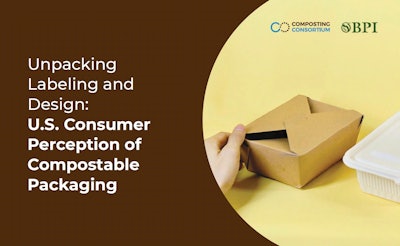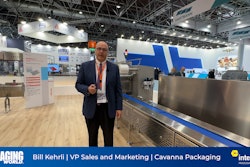Over the last decade, the volume of compostable materials in the market has been steadily increasing, and the market for compostable packaging is poised to grow 17% annually between 2020 and 2027. That’s according to Closed Loop Partners’ Composting Consortium, which adds that despite this anticipated growth, there remains limited publicly available data on U.S. consumer perception of compostable packaging design and labeling.
Notes the consortium, “As the compostable packaging industry continues to innovate rapidly, we must find ways to simplify and standardize approaches to the design and marketing of these new materials.” A recent study conducted by the Composting Consortium and the Biodegradable Products Institute (BPI) offers what it says is first-of-its-kind, publicly available data on U.S. consumer perceptions of compostable packaging.
The insights in the report are based on the results of a pilot co-led with BPI to test how different approaches in design and labeling affect how consumers and end-users identify and perceive compostable product packaging. The goal was to identify those design and labeling techniques that best improve the diversion of food-contact compostable packaging to the correct material stream.
The report, “Unpacking Labeling and Design: U.S. Consumer Perception of Compostable Packaging,” yielded five key insights:
1. Look-alike packaging made of non-compostable materials can mislead consumers.
Look-alike products and packaging are non-compostable plastic materials that are virtually indistinguishable from their compostable counterparts. Green coloring and tinting, leaf icons, and labels such as “made from plants” are often used on both recyclable and compostable packaging. This causes significant confusion among consumers, which can lead to improper disposal of packaging at end of life given “made from plants” does not always mean packaging is compostable. In fact, the study found that up to 50% of respondents said they would mistakenly place packaging labeled with “made from plants” in the composting bin.”
2. Consumers cannot distinguish between packaging labeled “biodegradable” and “compostable.” Up to 49% of respondents had difficulty distinguishing between the terms “compostable” and “biodegradable,” and four in 10 consumers inaccurately believe that biodegradable and compostable are the same thing. Only certified compostable packaging should be placed in composting collection bins. While all compostable packaging is biodegradable, not all biodegradable packaging is compostable. Biodegradable packaging is not held to the same regulatory standards as certified compostable packaging and is not designed for a controlled compost environment.
3. Consumers are confused about how to dispose of compostable packaging. Nearly one-third of respondents said they would incorrectly place compostable packaging in the recycling bin. Compostable packaging is not designed to be recycled and can contaminate the recycling stream if intermixed with conventional recyclable packaging. Cross contamination of recycling and composting with the wrong material is an expensive and pervasive problem.
4. Access does not equal understanding. Access to curbside organics collections at home or in public does not appear to improve understanding of where or how to dispose of compostable packaging. Even in areas like the Western region of the U.S.—where people are nearly twice as likely than the average American to have access to residential curbside composting—respondents still mistakenly believed they could place compostable packaging in the recycling bin.
5. Use of multiple, prominent labels is vital. Utilizing two to three design elements that communicate compostability on food-contact compostable packaging is most effective for consumer comprehension. Adding a trusted certification logo and larger “compostable” call out increased consumers’ ability to identify a package as compostable by up to 22%.
Solutions for Policymakers
According to the report, without clarity and harmonization of labeling designs and claims, consumer confusion will persist. “This confusion will make it impossible to achieve a shift to a circular economy—a more resilient system without waste,” it adds.
The Composting Consortium and BPI advise that the new consumer data from the report should inform policies that advance an economically viable, sustainable future for food-contact compostable packaging. A harmonized approach to state labeling policies would promote a higher likelihood of adoption and compliance among brands, manufacturers, convertors and consumers, helping reduce waste in the process. Among the actions suggested in the report:
1. Require independent third-party verification for compostable products and packaging to ensure they meet ASTM-D6400 standards or D6868 standards
2. Advocate for Federal Trade Commission “Green Guides” and policy language to hold “biodegradable” claims to the same standards as “certified compostable” claims.
3. Ensure products marketed as “made from plants” have qualified language to indicate to consumers whether packaging is recyclable or compostable
4. Prevent composting and recycling contamination through:
· Enforced, adequate labeling practices
· Trusted on-pack certification logos
· Prominent on-pack labeling and design, as designated by the certifier that does not interfere with other labeling regulations
· Increased consumer education
· Improved sortation technology for haulers and composting facilities PW




























